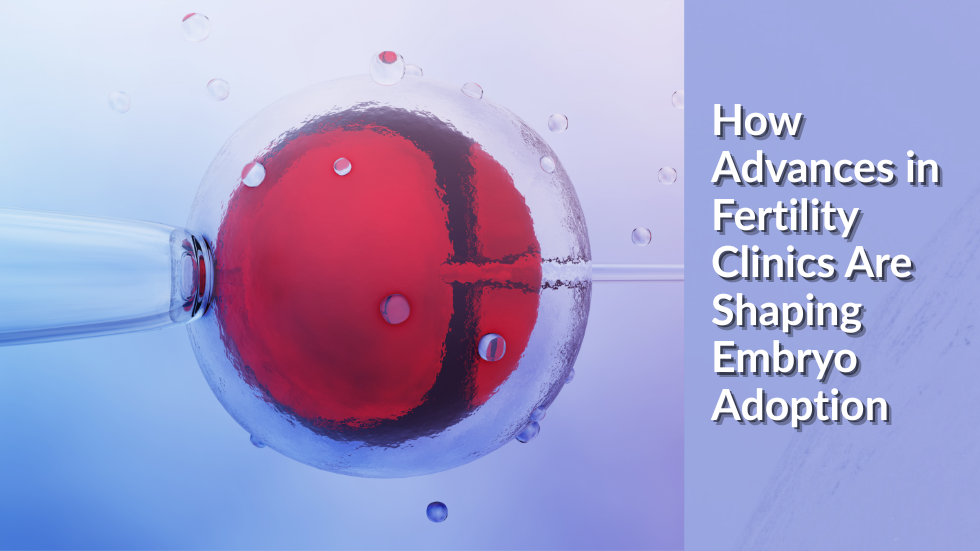As fertility science continues to advance, the landscape of embryo adoption is also changing, offering new opportunities for hopeful families and improving outcomes for frozen embryos waiting to be adopted. Two major developments—cryopreservation (freezing) methods and embryo testing—are having a significant impact on the IVF process. These developments, however, also highlight the need for families willing to adopt embryos, while presenting some ethical considerations along the way.
Whether you are considering embryo adoption or supporting someone through the process, understanding these fertility clinic trends is essential to making informed and compassionate decisions.
1. Vitrification: The Gold Standard in Embryo Freezing
Cryopreservation is the foundation of embryo adoption. Without safe and reliable freezing methods, embryos could not be stored for years, to be used later by the family who created them or placed with adoptive families. In recent years, vitrification has replaced traditional slow-freezing techniques as the gold standard in fertility clinics.
What is vitrification?
Vitrification is a rapid freezing process that turns embryos into a glass-like state almost instantly, preventing the formation of damaging ice crystals. Compared to older slow-freezing methods, vitrification has shown:
- Higher post-thaw survival rates, often exceeding 90%
- Increased implantation success, as embryos remain more intact after thawing
- Greater flexibility for embryo storage, with many remaining viable after years in cryostorage
For embryo adoption agencies and prospective parents, vitrification means that donated embryos—whether frozen recently or even a decade ago—have a strong chance of surviving the thawing process and developing into healthy pregnancies.
2. Embryo Testing: Balancing Innovation with Intention
In parallel with freezing improvements, embryo testing has become more advanced and widely used. Technologies such as preimplantation genetic testing for aneuploidy (PGT-A) and monogenic diseases (PGT-M) help fertility specialists assess the health and chromosomal stability of embryos before transfer.
Why PGT? Those who advocate for embryo testing cite several benefits:
- Improved pregnancy outcomes: PGT-A helps identify embryos with the correct number of chromosomes, which can reduce miscarriage risk and increase implantation success.
- Informed decision-making: For adoptive families, access to genetic information may help identify embryos that are most likely to thrive.
- Screening for inherited conditions: PGT-M can detect specific inherited genetic diseases, which may be important for families with known carrier status.
There are others who caution that PGT-A has limitations, as well as ethical implications:
- The procedure involves a biopsy to remove cells, which can cause damage to the embryo and prevent it from developing after the frozen embryo transfer.
- The Human Fertilization & Embryology Authority mentions the possibility of misdiagnosis or inaccurate diagnosis. When cells are removed from the embryo, they are being removed from the outer part, which eventually becomes the placenta. These cells are likely cells the embryo has already rejected from becoming part of the baby inside. Because the testing is performed on these “rejected” cells, there is a high chance that the tests will show abnormal results regardless of how healthy the cells becoming the baby are.
- When only one or two cells are biopsied, it is reasonable to believe that the rest of the cells might be completely healthy and normal! Taking such a small sample size, similar to any research study, usually negatively impacts the accuracy of the results.
- Embryos that are tested and labeled as “abnormal” are not likely to be given the chance to be transferred, as most clinics will not do an FET with abnormal embryos. This lead to the discarding of embryos.
- Many have begun to use this technology as a way to choose gender or other characteristics, meaning that embryos who are capable of developing into a healthy child but are not the desired sex, or who don’t possess other desired physical traits, are at risk of being discarded.
For these reasons, some embryo donation or adoption programs, including the Snowflakes® Embryo Adoption Program, do not encourage testing nor allow families to express a preference for receiving PGT-A tested embryos.
What does this mean for embryo adoption?
Many embryos available for adoption were created during IVF cycles that included genetic testing. As a result, some donated embryos may come with detailed information about their chromosomal status. This can be reassuring for adopting families—but it also raises questions about how embryos are selected and whether certain embryos are being left behind due to less-than-perfect test results.
While testing can be a powerful tool, it is important to remember that no test is perfect—and genetic testing does not guarantee a child’s future health. Some clinics and agencies are moving toward ethical guidelines that avoid dismissing embryos based solely on non-life-threatening conditions, promoting fair consideration of all embryos regardless of test results.
3. The Growing Number of Frozen Embryos in Storage
Due to improvements in freezing and IVF success rates, the number of frozen embryos in long-term storage continues to rise. Many IVF patients complete their families and are left with embryos they no longer plan to use.
This situation has increased both the availability of embryos for adoption and the need for adoptive families. Fertility clinics and embryo adoption agencies are collaborating to ensure these embryos have a chance at life—especially now that vitrification means embryos can be stored longer without a decline in viability.
Embryo adoption offers an option that is both practical and deeply meaningful: a way to give these embryos the opportunity to grow, develop, and be welcomed into loving homes.
Today’s fertility advancements—particularly in embryo freezing and genetic testing—are reshaping what is possible in embryo adoption. As survival rates improve and more information becomes available about each embryo, adopting families are better equipped to make informed, confident decisions.
At the same time, it is important to approach these tools with balance: using technology to support, not define, the value of every embryo. With the right knowledge and partnerships, embryo adoption continues to be a hopeful, compassionate path to family building.
To learn more about embryo donation and adoption, visit EmbryoAdoption.org.


Recent Comments